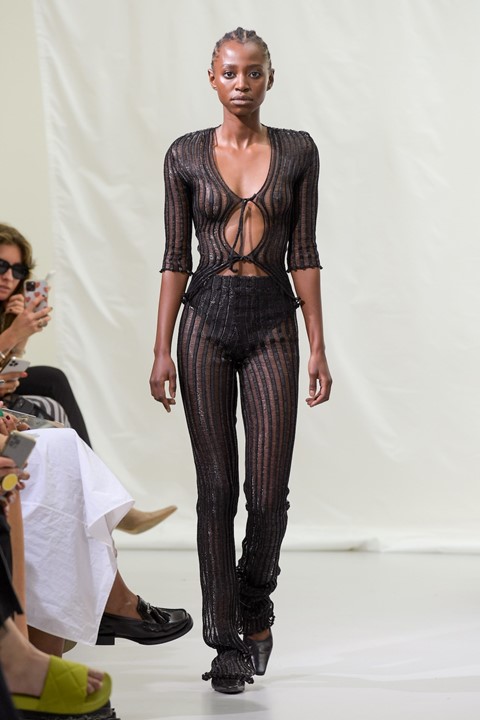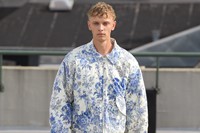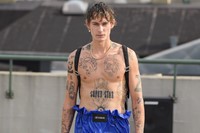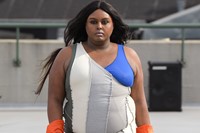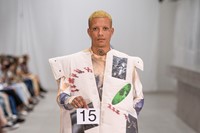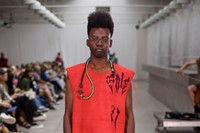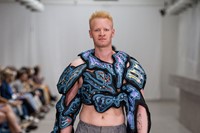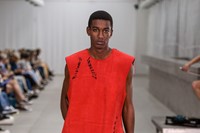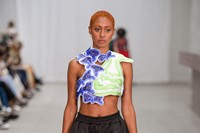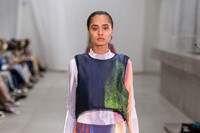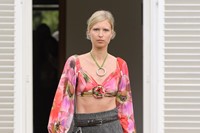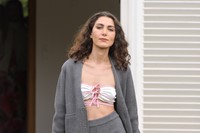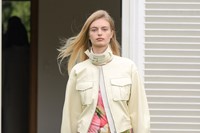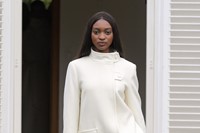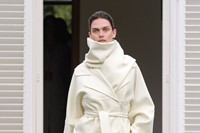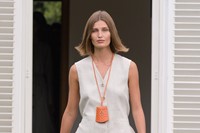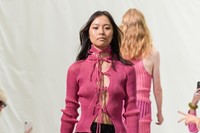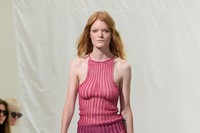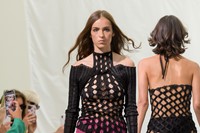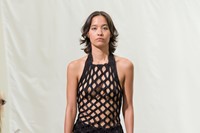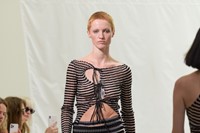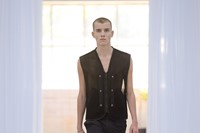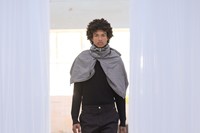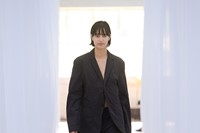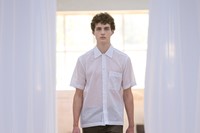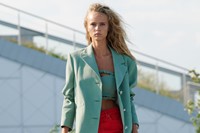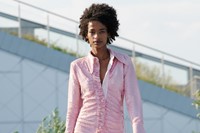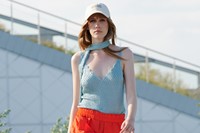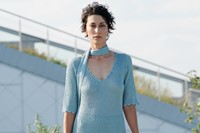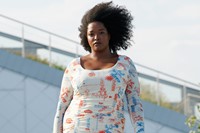One of the first international events to draw focus back to the physical show experience, Copenhagen Fashion Week Spring/Summer 2022 proved the Danish capital is one of the most exciting fashion hotspots right now
Kicking the three-day event off with an early 9.30 showtime, (di)vision’s catwalk debut brought an unexpected sensibility to Copenhagen Fashion Week’s usual set-up. It seemed like the combination of a live rock band, a windy car park rooftop and a diverse cast (which included local heroes Mouna Tougaard and Peter Dupont) was there to show us this season is more than just about frilly printed dresses, though there were plenty of those at other shows.
The brother-sister duo Nanna and Simon Wick started (di)vision three years ago out of a love for cutting and mixing existing garments into new silhouettes. Working within the limits of upcycling and patchwork that have become de rigueur with most brands over the past few seasons, they showed there is still plenty more to do while using those familiar techniques. Exposed seams connected mismatched panels in contrasting colours, as garments pulled and revealed body parts in a way they did back in the early noughties. This sense of carefree youthfulness carried through even in the tailoring with the stiff trousers and boxy jackets still finding a way to reveal skin.
One of Scandinavia’s most prestigious art schools, The Royal Danish Academy counts some pretty legendary names in product design and architecture as alumni, including Børge Mogensen and Kaare Klin. This year’s fashion cohort proved that this legacy extends into garment design too. Out of the 16 students that showcased their work as part of the graduate show titled Last Pieces, there was a plethora of contrasting stories on display, with ‘diversity, inclusivity and sustainability’ being some of the overarching themes.
Opening the show, Rikke Krogsgaard Mikkelsen played with historic references of the female form in the context of modern-day shapewear. Corsets and bustles interrupted the otherwise streamlined silhouettes and showed a new take on the bodycon standards. Jeppe Juel’s collection of six pieces named Amorphia was a sculptural trip for the eye that presented the idea of ”clothes as an extension of the body, physically and metaphorically, a second skin to our own”. Rediscovering the depths of his Kurdish heritage, Cengiz Güdücü designed an homage to loving himself as the longline silhouettes explored ”the limbo between art and fashion, that I find myself in”.
After a year of figuring things out, Catherine Saks and Barbara Potts decided to go away from their signature statement coats and delve deeper into the identity of their it-girl customer. Instead of singular pieces, they embarked on designing a full Saks Potts wardrobe with head-to-toe looks layering functional pieces that look considered and designed with a purpose. Set in the courtyard of the late Danish architect Arne Jacobson’s house (on the same street that Potts and Saks grew up on), the show reflected its location with practicality being one of the designs’ imperatives.
Taking the 60s via late 90s route, the line-up included bracelet-length jackets with matching skirts, bohemian dresses and even jeans, in that mid-rise wide-legged shape that works on most people. The looks were completed with bags in matching textiles and vintage Manolos dating back to the Carrie Bradshaw era, sourced directly from the shoe brand’s archive. And perhaps most excitingly, the majority of the garments from the show are already available to shop via the brand’s online store as the collection took the see-now, buy-now approach, with the rest dropping in a special pop-up shop in Copenhagen next month.
Each season, Copenhagen Fashion Week welcomes an emerging designer in the unofficial spotlight slot that allows them to debut as part of the schedule. For S/S22, this honorary moment belonged to Amalie Røge Hove’s eponymous brand. With five collections under the belt and a dedicated following that adores the signature ribbed knits, A. Roege Hove’s show justified all the buzz surrounding the brand. The look went beyond the theme of transparency and was instead focused on showcasing the versatility of the garments. “This was a rare opportunity to get so many different women in our clothes to tell different stories. That’s why the casting was such a big part of this process,” the designer explained, noting how the form of the garments changed depending on the shape of its wearer.
While all of the pieces were created in the stiff knit, the vision didn’t leave a singular impression. The variety of Y2K references (boleros are officially back!) mixed in with asymmetry and contrast in scale showed that the potential of A. Roege Hove’s ribbed knits go beyond the niche.
Being one of the few designers that decided to showcase her work via a film instead of a physical show, Louise Lyngh Bjerregaard had the task of garnering attention amid a packed schedule. However, this didn’t end up being much of a challenge for Bjerregaard, whose work exists in a world of its own. Visually unlike any other Danish fashion designer working right now, she creates work on a parallel timeline that collides references of past, present and future. Her work is avant-garde yet has a wearable aura thanks to the way the looks are built through contrasting ideas.
Working with a zero-waste policy and focusing on reworking deadstock textiles, yarns and existing garments, Bjerregaard pushes the limits of traditional understanding of artisanal techniques. Initially recognised for her knitwear, she decided to break away from that label and present her biggest outing yet. “I wanted to challenge myself and go out of my comfort zone by finally doing a runway show and proving I can do much more than that,” she noted. The collection was initially presented via an intimate salon-style show during Couture Week in Paris, where she relocated recently. The show day was recorded and transformed into a vibrant moving image with the help of the music producer and Kendrick Lamar collaborator Rune Rask who created a score for the film that was screened during CPHFW at the Charlottenborg Art Cinema.
While the menswear scene is still forming its signature Copenhagen look, Frederik Berner Kühl might have the solution. The emerging designer founded his business in 2019 and has since slowly but surely established himself as one to watch. His minimal yet functional outlook on design prioritises quality and sleekness in a similar sense that classic Danish design does. Sourcing his inspiration in the 1960s Italian movement Arte Povera and the work of artist Mario Merz, Kühl took Merz’s ethos into the fashion conversation for S/S22. This includes looking at the relationship between human and nature, how humans act in contemporary life and the idea of shelters which are expressed in [Merz’s] many igloo constructions.
Italian tailoring was a starting point when it came to the shapes, as Kühl finds a way to modernise that tradition. How can a black suit be elevated? It’s made in a loud, technical fabric that reflects light. A white workwear combo is layered with an almost-matching shirt underneath, the jacket’s sleeved thoughtfully pushed above the elbows. With the addition of zips and heavy hardware, Berner Kühl creates a design language that might not be the loudest, but definitely speaks volumes of its wearer taste level.
A label synonymous with Copenhagen Fashion Week, Ganni is one of those names that most look to see what the rest of the world will be wearing in the coming months. Creative Director Ditte Reffstrup has definitely cracked the code in dressing a wide range of personalities and this season is no different. On the rooftop of CopenHill, the Danish capital’s sustainable waste-to-energy power plant, the latest cast of #GanniGirls paraded in looks that were – in simplest terms – so Ganni. A contrasting mix of body conscious and oversized, floral dresses and clogs, multicoloured crochet knits and men’s tailoring.
Just next to the elevated catwalk was an artificial ski slope, which was mirrored through a heightened presence of sportswear references throughout the collection. “That’s an element that has always been there because I grew up doing sports – in my small town, it’s what everyone did,” Reffstrup says. But what stood out the most was a joie de vivre which permanently surrounds the phenomenon that is Ganni. ”I really wanted everyone to feel themselves. I’m 43, and over the past few years I had been thinking whether that means I have to dress a certain way. But after the pandemic, I have learned that the key is to embrace yourself – say yes to the world and say yes to yourself. That’s what makes it really sexy.”
